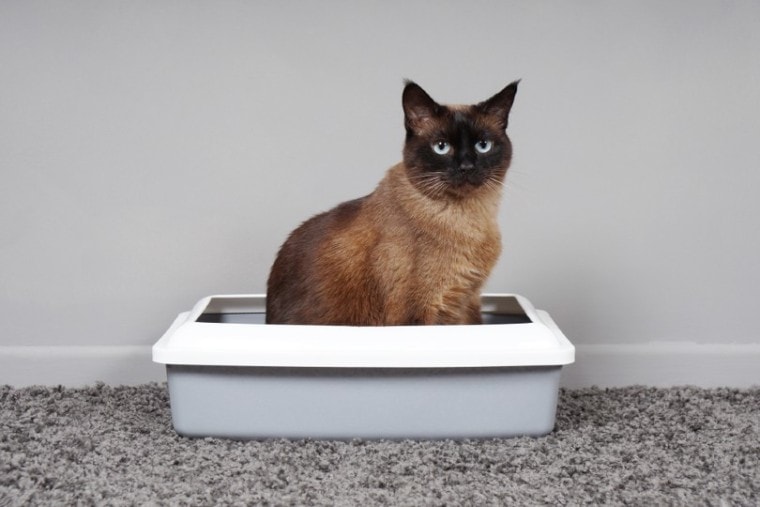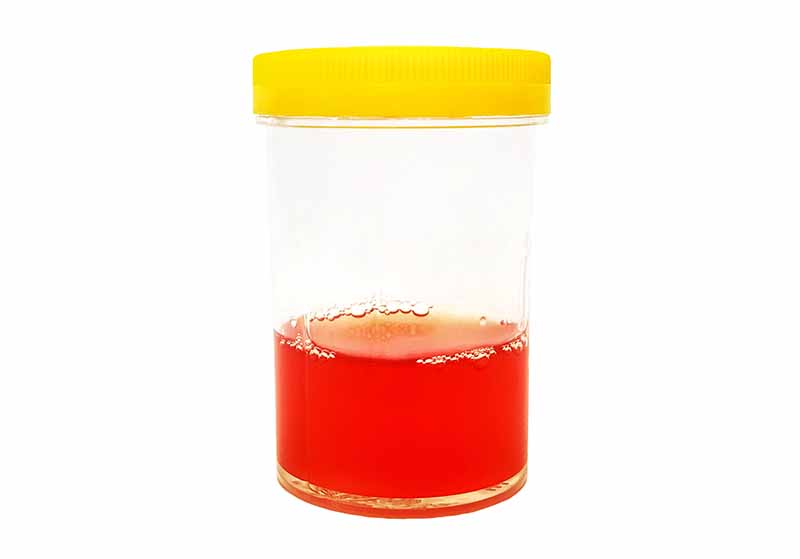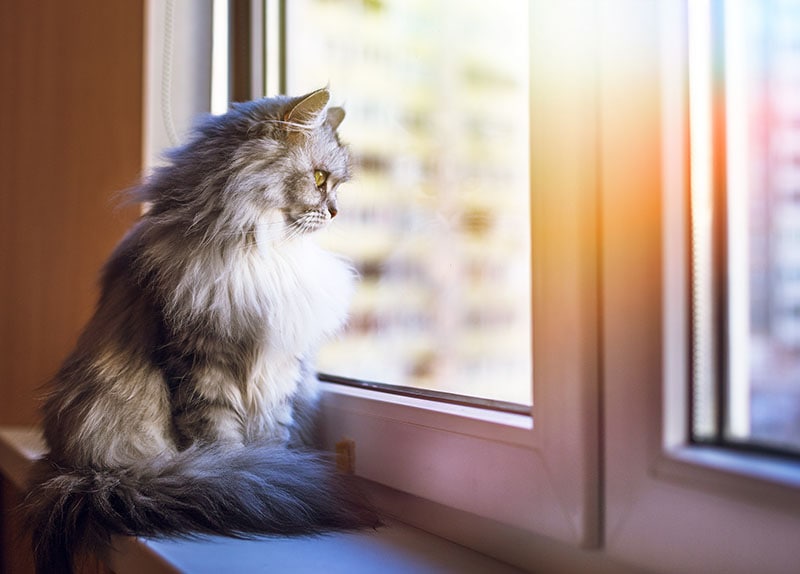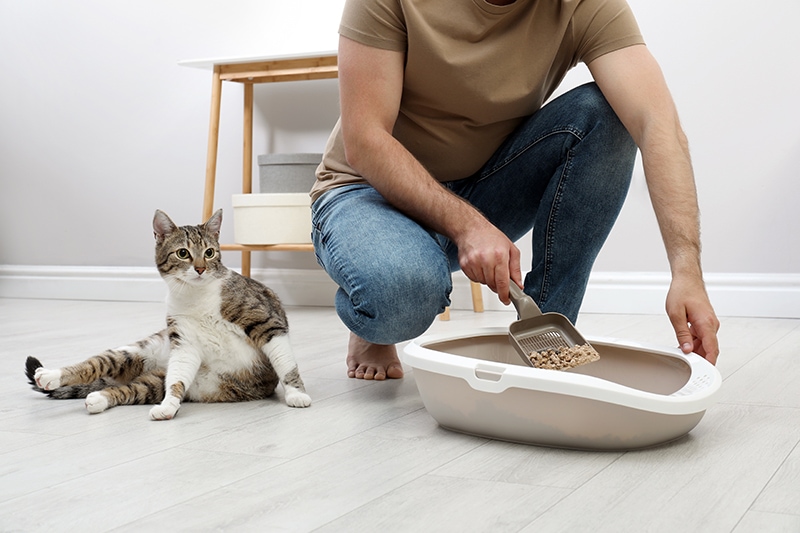
If you’ve found blood in your cat’s urine, the first thing you should do is contact your veterinarian. Bloody urine is often a sign of an underlying medical issue and can indicate the presence of serious (and extremely time-sensitive) conditions such as urinary blockages. Take a picture of any “evidence” and contact your veterinarian for guidance.
Be prepared to answer questions such as if your pet has recently been having difficulty peeing or straining while only producing small amounts of urine. Let your veterinarian know if your cat has been drinking or eating more or less and if they’ve exhibited any other signs of illness, such as lethargy or lack of interest in interacting. Your veterinarian will want you to bring your cat in for an examination.
What Does It Mean if I Found Blood in My Cat’s Urine?
Bloody urine isn’t a medical condition in and of itself. It’s called hematuria and is usually a sign of an underlying disease, infection, or condition.
What Causes Hematuria?
Blood in the urine can come from any part of the anatomy that urine travels through. This includes the kidneys, ureters, bladder and urethra. Hematuria can be caused by several problems, including urinary tract infections (UTIs), bladder conditions, cystitis, urinary tract blockages, and kidney disease.

What Does Blood in Cat Urine Look Like?
It can be difficult to see blood in your cat’s urine, particularly when it’s only in small amounts. Cat urine is normally clear, pale, and yellow, so if your pet’s pee turns red, pink, dark, cloudy or has blood clots in it, it’s time to contact your veterinarian. Cats with urinary tract issues often strain when going to the bathroom and only produce small amounts of pee.
Pets with irritated urinary tracts often gravitate towards using the bathroom on cool, smooth surfaces, such as bathroom tiles and kitchen floors. Contact your veterinarian immediately if your cat starts straining when urinating or begins heading to the litter box repeatedly without producing much, even if you don’t see evidence of blood.
How is Hematuria Treated?
Treatment depends largely on what’s causing the condition. Cats with UTIs are often prescribed antibiotics, and pets with bladder stones can sometimes be helped with dietary changes and increased hydration. Surgery is an option for pets that don’t respond to conservative treatment options. Cats with urinary blockages require urgent treatment, as untreated, the condition can be fatal.
Are There Ways to Prevent Hematuria?
Hematuria is usually a sign of some underlying condition, so keeping your cat in top physical and mental condition is the absolute best way to minimize the chances of your pet developing a disease that causes the condition. Ensuring your cat maintains a healthy weight, gets enough exercise and mental stimulation, has an appropriate living environment, and drinks enough water all go a long way toward keeping your buddy happy and healthy.
Weight Management
Overweight indoor cats are often at increased risk for developing cystitis and bladder stones.1 Ensuring your pet maintains an appropriate weight is critical to supporting your companion’s overall health and well-being.
Cats that weigh too much often have conditions such as osteoarthritis, diabetes, and even heart conditions, which can adversely impact your pet’s overall quality of life. Use the feeding guidelines on the packaging your cat’s food comes in to determine how much your cat should be eating to meet their health goals. Use food scales to prevent under or over-feeding.

Hydration
Many cats don’t get enough water, which is hard on their kidneys and increases the risk of developing urinary tract conditions. Cats often prefer to drink running water, as streams and creeks are often cleaner than standing water in the wild. Indoor cats’ instincts drive them to gravitate toward running water.
If your cat has a regular water bowl, consider swapping it for a cat fountain. Cat fountains encourage cats to indulge in just a few more sips of the good stuff by tapping into their natural preferences. Also, giving your cat more wet food is an easy way to boost its hydration since it contains up to 80% moisture.
Exercise & Mental Simulation
Cats usually do best when getting sufficient exercise and mental stimulation. Playtime is an easy way to increase your pet’s activity, provide them with love, and engage their senses. Stick with short sessions to keep things fun and interesting. Most cats get bored after 10 minutes of scampering and batting.
Ensure your cat has plenty of ways to stay occupied when you’re not around or busy. Plush toys and interactive games are great options, as are simple choices such as balls and crinkly toys that make fun noises when your cat gets hold of one. Food puzzles also give cats fun ways to use their skills and senses to obtain treats and an all-important sense of accomplishment!
Environmental Improvements
Many cats can be happy living indoors as long as their general environmental needs are met. In the wild, cats are both predators and prey, so they often prefer to relax when hanging out in high places with panoramic views.

Cat Trees & Platforms
Cats often thrive when given access to several high perches to hang out or retreat when uncomfortable. You can purchase a cat tree or install climbing platforms to provide elevated viewpoints. Cats living in stressful environments often benefit from having a safe space to head when overwhelmed, which is off-limits to dogs or kids and far away from loud, repetitive noises.
Scratching Posts
Scratching is an instinctual feline behavior that provides cats with a sense of security and comfort. Cats have scent glands in their paws that release pheromones when they scratch, leaving behind a familiar scent that often increases comfort as it smells like home. Give your pet a few types of scratching posts featuring different materials, and be liberal where you place them throughout your home.
Litter Box Maintenance
Cats can be particularly demanding regarding their litter boxes and will go to the bathroom elsewhere when they don’t consider their facilities sufficiently clean. Older cats sometimes have trouble making it into litter boxes with higher edges and are often at higher risk for conditions such as UTIs.
Placing multiple litter boxes around your house can make it easier for cats to use the bathroom without navigating stairs or walking too far. And consider scooping and changing your cat’s litter box more often than normal to ensure it has a squeaky clean place to go to the bathroom.

Summary
Hematuria, or blood in your cat’s urine, is always a sign that should be evaluated by your veterinarian. If you see blood in your pet’s urine or notice your cat straining to pee, speak with your veterinarian to determine the best course of action. You should do the same if your pet starts going to the bathroom frequently while only producing small amounts of urine or begins peeing outside the litterbox. Cats with urinary blockages should be seen immediately since the condition can be fatal without prompt treatment.
Featured Image Credit: Axel Bueckert, Shutterstock







